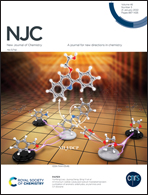Pseudoionone synthesis from citral and acetone in a fixed bed catalytic reactor with lanthanum modified calcium oxide†
Abstract
The current industrial process of pseudoionone synthesis from citral uses a homogeneous catalyst with excessive acetone as a solvent-cum reactant in a stirred tank batch reactor. This process has several disadvantages, such as extensive corrosion of the reactor, generation of a large amount of high pH effluent waste, and the use of an excess of acetone, which can lead to byproduct formation due to the self-condensation of acetone. Using a heterogeneous catalyst with a solventless flow process is a promising way to overcome such problems and make the process green. Pseudoionone was synthesized using 1 wt% La2O3/CaO as the catalyst. The conventional batch process was converted into a flow process using a lab-scale fixed bed reactor. Acetone was a reactant, as well as a solvent. A minimum mole ratio of citral to acetone (1 : 4) was required to make the process nearly solventless with maximum conversion and selectivity. It also prohibited the self-condensation of citral. A 1 wt% La2O3/CaO catalyst was synthesized by an impregnation method with La(NO3)3·6H2O as a lanthanum precursor with calcium oxide as an active support. To evaluate the properties of the 1 wt% La2O3/CaO catalyst, various characterization techniques like XRD, SEM, TEM, BET, CO2-TPD, and XPS were used. Citral conversion of 91% with 90% pseudoionone selectivity was attained at a WHSV of 3 h−1 and 130 °C. The catalyst was robust, active, and selective, which could be used successfully to develop a solventless flow process of pseudoionone synthesis.



 Please wait while we load your content...
Please wait while we load your content...